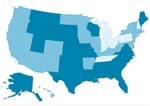Business
Insuring Gen Y: Limited plans only a start
■ With 20-something adults a large and fast-growing portion of the uninsured, health plans are tailoring products for them. But the effort doesn't always pass muster with physicians also trying to find ways to cover the uninsured.
By Jonathan G. Bethely — Posted July 17, 2006
- WITH THIS STORY:
- » A Tonik for young folk
- » Young and uninsured: What it costs
- » Related content
To health plans, the largest, fastest-growing segment of the uninsured is not so much a problem as a marketing opportunity.
That segment is people ages 19 to 29, 13.7 million of whom were uninsured in 2004 (out of about 46 million uninsured Americans total), according to the Commonwealth Fund. That was a 20% increase over 2000.
Often the young and uninsured lose coverage when high school or college graduation leaves them ineligible for their parents' policies, or when they age out of state Children's Health Insurance Programs. Nearly 40% of college graduates and about half of high school graduates who don't go on to college will be uninsured for a period during the first year after graduation, according to the fund, which studies health issues.
But there is a growing belief among health plans and physicians that the high uninsured rate among 20-somethings is not all an accident of age, but that significant numbers of young adults decide not to buy insurance because they believe it's too expensive for the little care they seek.
Insurers and physicians each have made clear that they have a stake in getting the young and healthy onto the insurance rolls. Health plan company stocks are no longer the darlings of Wall Street, with investors believing that the industry right now isn't going to be able to push profit margins much higher. Meanwhile, according to Families USA, the average increase in premiums is $922 for families and $341 for individuals because of the number of uninsured Americans. Physicians provide, on average, $2,000 worth of uncompensated care every week.
But insurers and physicians don't always see eye-to-eye on how to get the young and healthy onto the insurance rolls. Insurers are having some success selling young adults on health savings accounts, which are generally supported by organized medicine. They're also selling Generation Y on low-cost plans that cover doctor visits and a few minor procedures, but exclude anyone needing chronic care, or prenatal care -- a marketing move not so popular with physicians.
Meanwhile, organized medicine has thrown its support behind legislation to require those who can to buy high-deductible, catastrophic health insurance, a move not so popular with insurers.
"Extreme" health insurance
Insurers have a name for Gen Yers who could, but don't, buy insurance: "young invincibles." "Young people are part of this 'prove-it-to-me' generation," said Stephen Neeleman, MD, a general surgeon and CEO of HealthEquity, a provider of HSAs for insurers and employers based in American Fork, Utah. "They want to see that there's going to be a financial benefit to getting insurance."
Laurie Brubaker, head of Aetna's individual markets division, said her company's research finds six out of 10 adults ages 19 to 29 are uninsured, in part because only 60% of businesses they work for offer insurance. When they have to decide individually, Gen Yers demand the same sort of age-specific personal service and marketing they have come to expect from just about every other sector of the economy.
"This is a population that has grown up on the Internet and with things that have been customized for them," Brubaker said. "We gear all of our solutions toward that. We give them options -- they don't want to be force-fed into a solution. [We say,] 'Based on where you live today, here's the type of product that we think will work for you.' It's a combination of personalization and choice, and it puts them in control."
Part of insurers' strategy for marketing to 20-somethings is creating starter plans with catchy identities.
Leading the way is WellPoint, which two years ago created Tonik, a series of individual health plans accompanied by a marketing program and Web site featuring silhouettes of skateboarders and other presumed hip young people. The plans, with names such as "Thrill Seeker" and "Calculated Risk-taker," cost anywhere from $69 to $90 per month, with co-pays from $20 to $40 per doctor visit, and deductibles from $3,000 to $5,000.
The plans have limited coverage and are mostly for the occasional doctor visit or trip to the emergency department to set a broken bone.
The Tonik plans and their "extreme" marketing have been mocked on Comedy Central's "The Daily Show," a news satire program popular among the demographic WellPoint is trying to reach. The plans also have been criticized by physicians for being too limited in their coverage.
"Physicians are concerned about these plans because there are some significant exclusions that down the road can be problematic," said Susan Strate, MD, chair of the Texas Medical Assn.'s council on socioeconomics. "Another issue is, do people buying the plan have full awareness of what they're getting?"
Physician efforts have been focused on getting anyone who is uninsured -- regardless of age -- coverage for catastrophic care and evidence-based preventive care. The AMA voted at its Annual Meeting to support legislation, such as that which passed recently in Massachusetts, requiring individuals and families earning more than 500% of the federal poverty level ($49,000 for an individual and $100,000 for a family of four) to obtain a minimum level of such insurance. The AMA also supports a system of Massachusetts-style tax credits and subsidies to support a similar requirement for those earning less than 500% of the poverty level.
"Both pieces [catastrophic and preventive care] are crucial for young adults," said AMA Trustee Ardis D. Hoven, MD, an internal medicine and infectious disease specialist in Lexington, Ky.
WellPoint says that despite the criticism, Tonik is selling well. So well that, in California, where it was introduced, it's the company's second-most popular product, behind its PPO offerings. It's now available in Colorado and Nevada, and WellPoint is rolling out a similar product in Texas under the brand name Sound, to be administered by UniCare, also owned by WellPoint.
"We found a niche market that we're successful at," said WellPoint spokesman Robert Alaniz. "But more importantly, we're chipping away at the uninsured rate."
Alaniz said WellPoint officials hope young people attracted to the less-expensive health insurance will, by the time they are old enough to seek more comprehensive coverage, stay with WellPoint products. Because of Tonik's success, WellPoint is looking to create products for the Hispanic community and the young retiree market.
Aetna's Brubaker and representatives of other plans say their youth offerings are more comprehensive but have the same goal of getting young people insured while building brand loyalty.
Plans also like 20-somethings because of the assumption that they are healthy. "If you look at a population, certainly the utilization is going to be less than early retirement," Brubaker said.
Rita Gunther-McGrath, PhD, associate professor at the Columbia Business School, said insurers are able to offer niche products thanks to the recent, rapid consolidation in the health insurance industry, which allows plans to focus more on meeting specific needs of the population it has. But she said this can be difficult to maintain.
"You can't know if someone 25 is completely healthy," Dr. Gunther-McGrath said. For that reason, Gunther-McGrath said insurers are banking on the prospect that young healthy people who sign up for these plans will not use them.
"As a strategy it can work very nicely," Gunther-McGrath said. "Insurance is just boring. Just out of the bat anything that's mildly different is going to attract attention."
The young and healthy remain a largely untapped market, said Renee Guariglia, executive vice president of Falcone Associates, a member of the Independent Insurance Agents and Brokers of New York, but the health savings account industry is also eyeing it.
Dr. Neeleman, who runs an HSA, said young people and healthy people "fear the major medical event that could financially ruin you, and on the other hand don't like the idea of your premium dollars going to someone else." Dr. Neeleman said about one-third of his 35,000 customers are younger than 30, consistent with surveys showing similar proportions of interest from that age group among the 3 million Americans who are in HSA-eligible, high-deductible health plans.
"They like investing in their own health savings accounts that continue to grow," said Dr. Neeleman, and the tax-free savings are portable from job to job.
While health insurance companies scramble for market share, hematologist-oncologist Jack Evjy, MD, said the true issue is convincing young adults that they need insurance.
"We live in a culture where most of us feel if something bad happens to us that someone is going to care for us, " said Dr. Evjy, a former president of the Massachusetts Medical Society who has retired from practice but is still active in the management of his group, Quincy, Mass.-based Commonwealth Hematology Oncology. "Oftentimes when you're young and healthy, the last thing you're thinking about is your health."












